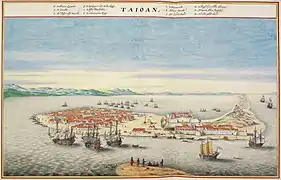Investment
To invest is to allocate money in the expectation of some benefit in the future.
In finance, the benefit from an investment is called a return. The return may consist of a gain or a loss realized from the sale of a property or an investment, unrealized capital appreciation (or depreciation), or investment income such as dividends, interest, rental income etc., or a combination of capital gain and income. The return may also include currency gains or losses due to changes in the foreign currency exchange rates.
Investors generally expect higher returns from riskier investments. When a low-risk investment is made, the return is also generally low. Similarly, high risk comes with high returns.
Investors, particularly novices, are often advised to adopt a particular investment strategy and diversify their portfolio. Diversification has the statistical effect of reducing overall risk.
Investment and risk
An investor may bear a risk of loss of some or all of their capital invested. Investment differs from arbitrage, in which profit is generated without investing capital or bearing risk.
Savings bear the (normally remote) risk that the financial provider may default.
Foreign currency savings also bear foreign exchange risk: if the currency of a savings account differs from the account holder's home currency, then there is the risk that the exchange rate between the two currencies will move unfavourably so that the value of the savings account decreases, measured in the account holder's home currency.
In contrast with savings, investments tend to carry more risk, in the form of both a wider variety of risk factors and a greater level of uncertainty.
History



The Code of Hammurabi (around 1700 BC) provided a legal framework for investment, establishing a means for the pledge of collateral by codifying debtor and creditor rights in regard to pledged land. Punishments for breaking financial obligations were not as severe as those for crimes involving injury or death.[11]
In the medieval Islamic world, the qirad was a major financial instrument. This was an arrangement between one or more investors and an agent where the investors entrusted capital to an agent who then traded with it in hopes of making a profit. Both parties then received a previously settled portion of the profit, though the agent was not liable for any losses. Many will notice that the qirad is similar to the institution of the commenda later used in western Europe, though whether the qirad transformed into the commenda or the two institutions evolved independently cannot be stated with certainty.[12]
Amsterdam Stock Exchange is considered to be the world's oldest stock exchange. Established in 1602 by Dutch East India Company, the company issued the first shares on the Amsterdam Stock Exchange. [13] In the early 1900s, purchasers of stocks, bonds, and other securities were described in media, academia, and commerce as speculators. Since the Wall Street crash of 1929, and particularly by the 1950s, the term investment had come to denote the more conservative end of the securities spectrum, while speculation was applied by financial brokers and their advertising agencies to higher risk securities much in vogue at that time.[14] Since the last half of the 20th century, the terms speculation and speculator have specifically referred to higher risk ventures.
Investment strategies
Value investment
A value investor buys assets that they believe to be undervalued (and sells overvalued ones). To identify undervalued securities, a value investor uses analysis of the financial reports of the issuer to evaluate the security. Value investors employ accounting ratios, such as earnings per share and sales growth, to identify securities trading at prices below their worth.
Warren Buffett and Benjamin Graham are notable examples of value investors. Graham and Dodd's seminal work, Security Analysis, was written in the wake of the Wall Street Crash of 1929.[15]
The price to earnings ratio (P/E), or earnings multiple, is a particularly significant and recognized fundamental ratio, with a function of dividing the share price of the stock, by its earnings per share. This will provide the value representing the sum investors are prepared to expend for each dollar of company earnings. This ratio is an important aspect, due to its capacity as measurement for the comparison of valuations of various companies. A stock with a lower P/E ratio will cost less per share than one with a higher P/E, taking into account the same level of financial performance; therefore, it essentially means a low P/E is the preferred option.[16]
An instance in which the price to earnings ratio has a lesser significance is when companies in different industries are compared. For example, although it is reasonable for a telecommunications stock to show a P/E in the low teens, in the case of hi-tech stock, a P/E in the 40s range is not unusual. When making comparisons, the P/E ratio can give you a refined view of a particular stock valuation.
For investors paying for each dollar of a company's earnings, the P/E ratio is a significant indicator, but the price-to-book ratio (P/B) is also a reliable indication of how much investors are willing to spend on each dollar of company assets. In the process of the P/B ratio, the share price of a stock is divided by its net assets; any intangibles, such as goodwill, are not taken into account. It is a crucial factor of the price-to-book ratio, due to it indicating the actual payment for tangible assets and not the more difficult valuation of intangibles. Accordingly, the P/B could be considered a comparatively conservative metric.
Intermediaries and collective investments
Investments are often made indirectly through intermediary financial institutions. These intermediaries include pension funds, banks, and insurance companies. They may pool money received from a number of individual end investors into funds such as investment trusts, unit trusts, SICAVs, etc. to make large-scale investments. Each individual investor holds an indirect or direct claim on the assets purchased, subject to charges levied by the intermediary, which may be large and varied.
Approaches to investment sometimes referred to in marketing of collective investments include dollar cost averaging and market timing.
Famous investors
Investors famous for their success include Warren Buffett. In the March 2013 edition of Forbes magazine, Warren Buffett ranked number 2 in their Forbes 400 list.[17] Buffett has advised in numerous articles and interviews that a good investment strategy is long-term and due diligence is the key to investing in the right assets.
Edward O. Thorp was a highly successful hedge fund manager in the 1970s and 1980s who spoke of a similar approach.[18]
The investment principles of both of these investors have points in common with the Kelly criterion for money management.[19] Numerous interactive calculators which use the Kelly criterion can be found online.[20]
Investment valuation
Free cash flow measures the cash a company generates which is available to its debt and equity investors, after allowing for reinvestment in working capital and capital expenditure. High and rising free cash flow, therefore, tend to make a company more attractive to investors.
The debt-to-equity ratio is an indicator of capital structure. A high proportion of debt, reflected in a high debt-to-equity ratio, tends to make a company's earnings, free cash flow, and ultimately the returns to its investors, riskier or volatile. Investors compare a company's debt-to-equity ratio with those of other companies in the same industry, and examine trends in debt-to-equity ratios and free cashflow.
See also
- Asset
- Capital accumulation
- Capital gains tax
- Diversification (finance)
- EBITDA
- Financial risk
- Foreign direct investment
- Fundamental analysis
- Fundamental Analysis Software
- Hedge fund
- List of countries by gross fixed investment as percentage of GDP
- List of economics topics
- Market sentiment
- Mortgage investment corporation
- Rate of return
- Socially responsible investing
- Specialized investment fund
- Time value of money
- Time-weighted return
- Mutual Fund
References
- Brenner, Reuven (1994). Labyrinths of Prosperity: Economic Follies, Democratic Remedies. (University of Michigan Press, 1994), p. 57-60
- Moore, Jason W. (2010b). "'Amsterdam is Standing on Norway' Part II: The Global North Atlantic in the Ecological Revolution of the Long Seventeenth Century," Journal of Agrarian Change, 10, 2, p. 188–227
- Chen, Piera; Gardner, Dinah: Lonely Planet: Taiwan [10th edition]. (Lonely Planet, 2017, ISBN 978-1786574398).
- Shih, Chih-Ming; Yen, Szu-Yin (2009). The Transformation of the Sugar Industry and Land Use Policy in Taiwan, in Journal of Asian Architecture and Building Engineering [8:1], pp. 41–48
- Tseng, Hua-pi (2016). Sugar Cane and the Environment under Dutch Rule in Seventeenth Century Taiwan, in Environmental History in the Making, pp. 189–200
- Estreicher, Stefan K. (2014), 'A Brief History of Wine in South Africa,'. European Review 22(3): pp. 504–537. doi:10.1017/S1062798714000301
- Fourie, Johan; von Fintel, Dieter (2014), 'Settler Skills and Colonial Development: The Huguenot Wine-Makers in Eighteenth-Century Dutch South Africa,'. The Economic History Review 67(4): 932–963. doi:10.1111/1468-0289.12033
- Thompson, Laurence G. (1964), 'The Earliest Chinese Eyewitness Accounts of the Formosan Aborigines,'. Monumenta Serica 23(1): 163–204. Laurence G. Thompson (1964) noted, "The most striking fact about the historical knowledge of Formosa is the lack of it in Chinese records. It is truly astonishing that this very large island, so close to the mainland that on exceptionally clear days it may be made out from certain places on the Fukien coast with the unaided eye, should have remained virtually beyond the ken of Chinese writers down until late Ming times (seventeenth century)."
- Goetzmann, William N.; Rouwenhorst, K. Geert (2005). The Origins of Value: The Financial Innovations that Created Modern Capital Markets. (Oxford University Press, ISBN 978-0195175714))
- Goetzmann, William N.; Rouwenhorst, K. Geert (2008). The History of Financial Innovation, in Carbon Finance, Environmental Market Solutions to Climate Change. (Yale School of Forestry and Environmental Studies, chapter 1, pp. 18–43). As Goetzmann & Rouwenhorst (2008) noted, "The 17th and 18th centuries in the Netherlands were a remarkable time for finance. Many of the financial products or instruments that we see today emerged during a relatively short period. In particular, merchants and bankers developed what we would today call securitization. Mutual funds and various other forms of structured finance that still exist today emerged in the 17th and 18th centuries in Holland."
- "The Code of Hammurabi". The Avalon Project; Documents in Law, History and Diplomacy.
- Robert H. Hillman, "Limited Liability in Historical Perspective", (Washington and Lee Law Review, Spring 1997), Benedikt Koehler, "Islamic Finance as a Progenitor of Venture Capital", (Economic Affairs, December 2009)
- "Which is the oldest stock exchange in the world?".
- "The 1929 Stock Market Crash". eh.net. Retrieved 2020-01-16.
- Graham, Benjamin; Dodd, David (2002-10-31). Security Analysis: The Classic 1940 Edition (2 ed.). New York; London: McGraw-Hill Education. ISBN 9780071412285.
- "Price-Earnings Ratio - P/E Ratio". Investopedia.
- Editor. "Forbes 400: Warren Buffett". Forbes Magazine. Retrieved 1 March 2013.CS1 maint: extra text: authors list (link)
- Thorp, Edward (2010). Kelly Capital Growth Investment Criterion. World Scientific. ISBN 9789814293495.
- "The Kelly Formula: Growth Optimized Money Management". Seeking Alpha. Healthy Wealthy Wise Project.
- Jacques, Ryan. "Kelly Calculator Investment Tool". Archived from the original on 2012-03-20. Retrieved 7 October 2008.
External links
| Wikiquote has quotations related to: Investment |
| Wikimedia Commons has media related to Investments. |
| Wikisource has the text of The New Student's Reference Work article "Investments". |
| Look up investment in Wiktionary, the free dictionary. |